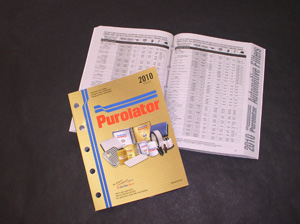 Purolator announces the publication of its 2010 Automotive Filter Catalog (PUCT110) containing the most current filter-related information. This catalog is especially designed to meet the needs of automotive service and retail professionals and do-it-yourselfers (DIYers).
Purolator announces the publication of its 2010 Automotive Filter Catalog (PUCT110) containing the most current filter-related information. This catalog is especially designed to meet the needs of automotive service and retail professionals and do-it-yourselfers (DIYers).
Well organized and easy-to-read, this 968-page catalog covers a wide range of filter applications from model year 1985 to 2010 for domestic and import cars, vans, SUVs and light trucks as well as motorcycles and ATVs. Coverage includes Purolator’s premium-grade PureONE oil and air filters, Purolator Classic oil and air filters, and cabin air, fuel, and transmission filters.
“Purolator’s 2010 automotive filter catalog is an extremely handy reference tool for any shop or retail shelf,” said Ramon Nuñez, director of filtration for Robert Bosch LLC, joint venture owner of Purolator.
This trilingual catalog can help you find all the filter information you need in one of three languages you might be familiar with – English, Spanish or French. Apart from the regular application information, there are cross-reference notes, technical bulletins, catalog abbreviations and footnotes, decimal and metric equivalents, new products guide/obsolete types/superseding types, hotline phone numbers, quick change cross reference tables and much more.
The catalog’s highly attractive gold cover makes it instantly recognizable. The full-color inside front cover showcases PureONE air and oil filters that feature Purolator’s exclusive micronic filtration media that filters out the smallest grains of dust and dirt. The inside back cover, on the other hand, presents an image and description of the BreatheEASY cabin air filter which protects the passengers inside a vehicle from harmful contaminants that can enter through the ventilation system.
The Purolator 2010 Automotive Filter Catalog can be searched either by make, year, model, and engine or cross-referenced by the manufacturer’s or competitor’s number.
Also available to everyone – service professionals and do-it-yourselfers – are the Purolator PROs (Purolator Response Office), a team of experts who will answer any filter-related question, free of charge, via personal e-mail within 48 hours. Purolator PROs can be contacted through the Purolator website at www.purolatorautofilters.net.
To learn more about Purolator filters and the filtration category, visit www.purolatorautofilters.net.













